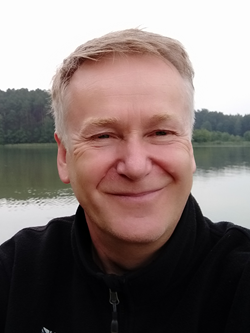![]() Plenary speakers
Plenary speakers

Professor Dariusz Ficek is a physicist and a specialist in oceanography and limnology, affiliated with the Pomeranian University in Słupsk. He obtained his PhD and habilitation degrees in Earth sciences at the Institute of Oceanology of the Polish Academy of Sciences in Sopot, focusing on marine physics, biophysics, and satellite remote sensing of marine and inland waters. His research involves the modeling and analysis of bio-optical and photochemical properties of the Baltic Sea and Polish lakes. Professor Ficek has held significant organizational positions at the university, including Vice-Dean for Science and Vice-Rector for Science, and has coordinated numerous national and international research projects related to bio-optics, aquatic environmental physics, and water quality monitoring. Among his major achievements is the development of models for quantum photosynthetic efficiency and the optical properties of natural waters, which are used, among others, in the Baltic Sea Satellite Environmental Monitoring System (SatBałtyk). Professor Ficek is the author of numerous peer-reviewed scientific publications and serves as a supervisor and reviewer of doctoral, master’s, and bachelor’s theses, actively supporting the development of young scientific staff. His scientific work integrates elements of physics, biology, and environmental sciences, making him a recognized expert in interdisciplinary aquatic environment research. Professor Ficek also participates in scientific conferences and promotes knowledge in the fields of aquatic physics and chemistry.
BIO-OPTICAL PROPERTIES OF POLISH LAKES
Dariusz FICEK, Magdalena PAWLIK, Damian STOLTMANN
Pomeranian University in Slupsk, Poland
Abstract
This study presents the results of research on the bio-optical properties of selected Polish lakes. The analyses encompassed a diverse set of water bodies located in three national parks: Bory Tucholskie National Park, Słowiński National Park, and Tatra National Park. In the waters of these lakes, the concentration and characteristics of optically active substances (OAS)—including chlorophyll a, suspended particulate matter (SPM), and colored dissolved organic matter (CDOM)—were determined. Fundamental optical parameters were measured, such as downwelling and upwelling irradiance, diffuse attenuation coefficient of underwater light, Secchi depth, and light absorption and scattering coefficients. Advanced optical instruments were used in the study, including a HyperPro profiler with three hyperspectral radiometers (Satlantic), a HydroScat-6P multispectral backscattering meter (HobiLabs), and an AC-9 absorption and attenuation meter (WET Labs). The use of multiple complementary devices allowed for a deeper analysis of underwater light fields and the role of absorption and scattering by OAS in shaping the color of lake waters and the underwater light climate. The spectral composition and intensity of the light field, strongly determined by the water’s optical properties, were reflected in both the measured diffuse attenuation coefficient (Kd) and remote sensing reflectance (Rrs). Additionally, the optical properties of the individual lake water components were analyzed. In collected water samples, light absorption by suspended matter was measured and separated into two components: those associated with phytoplankton pigments and other particulate matter. Spectral absorption characteristics of dissolved substances were also examined. In samples from oligotrophic mountain lakes, elevated absorption of UV radiation was observed, indicating the presence of mycosporine-like amino acids (MAAs). It was also found that the UV absorption coefficient of phytoplankton biomass increased with the altitude of the lakes. Comparison with previous studies, such as those in Alpine lakes, suggests that phytoplankton in Tatra lakes synthesize MAAs, which serve a protective function against UV radiation, whose intensity increases with elevation. Conducting this type of research is strongly recommended, as numerous publications highlight the necessity of using region-specific empirical relationships to account for local optical properties of lake water constituents. An increase in the number of such bio-optical studies is crucial for better utilization of satellite data based on lake water color.
Keywords: light absorption and scattering, optically active substances, diffuse attenuation coefficients, remote sensing reflectance, Polish Lakes

